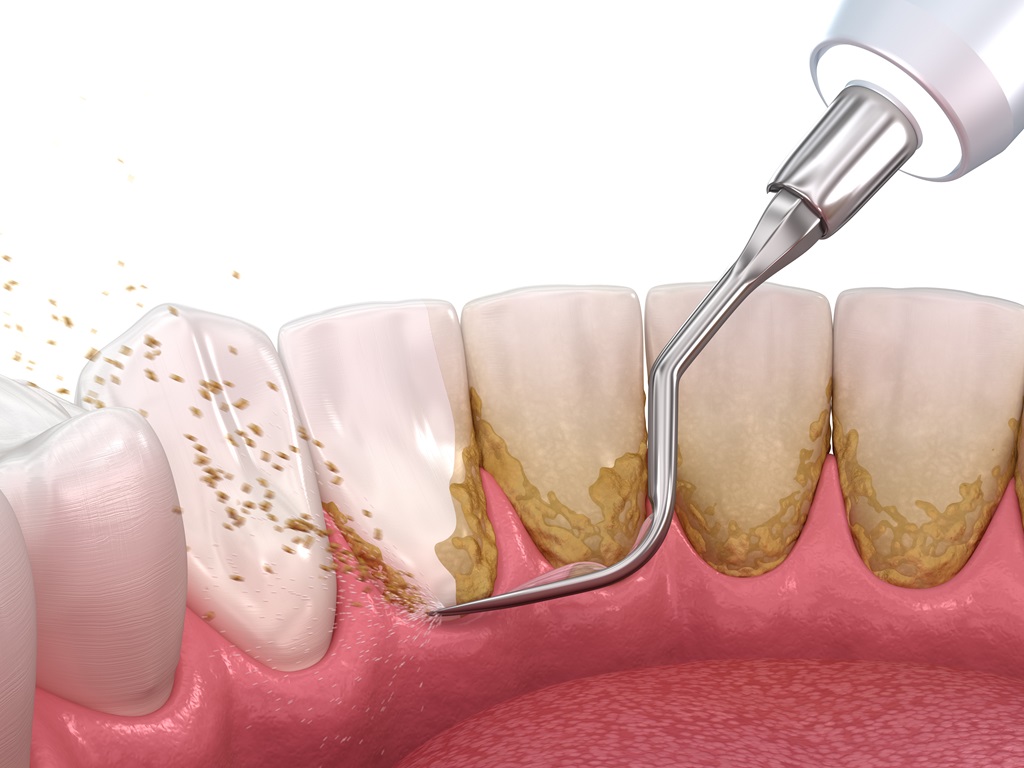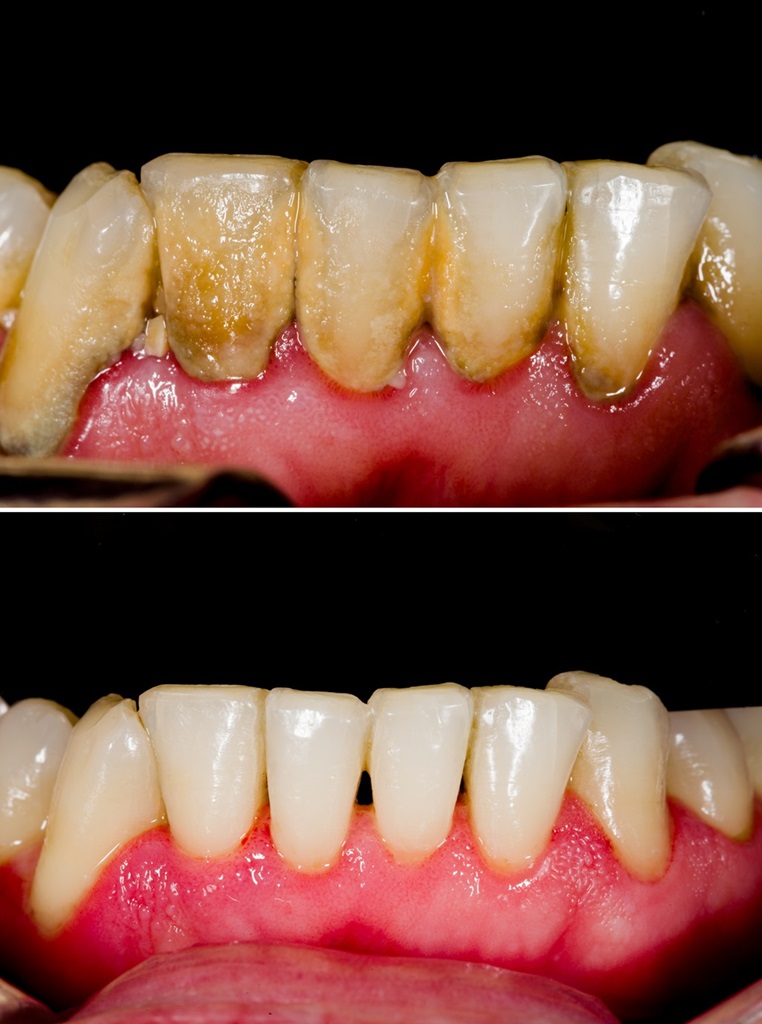Dental scaling
Ultrasonic tartar removal for healthy teeth and gums
You must have heard countless times from your dentist that smoking or excessive sugar consumption are habits that you should avoid. Regular brushing and flossing are essential for healthy teeth. Adequate oral hygiene also includes regular dental check-ups and tartar removal. In our clinic, the most modern procedures are available, which you can use to preserve the beauty and health of your teeth. Now you can learn everything about ultrasonic tartar removal. Come and join us!
You may be a fan of regular brushing and flossing, but even the most careful oral hygiene does not completely remove plaque, which turns into tartar over time and cannot be removed at home. That's why it's important to go for a dental screening and cleaning at least twice a year to protect the health of your oral cavity!
Tartar removal is a key part of dental cleanings. Although this process is essential to maintaining oral health, it is often considered the most unpleasant part. Fortunately, today there is a much more comfortable and painless method for effective cleaning of the teeth - this is ultrasonic tartar removal.
The history of ultrasonic tartar removal
The discovery of ultrasonic tartar removal can be traced back to the middle of the 20th century, when technological innovations began to revolutionize dental offices.
An American periodontist introduced the first ultrasonic device in the 1950s, pioneering the use of ultrasonic vibrations to remove tartar. Since then, advances in materials, technology and design have improved these devices, making them a vital tool in dental offices worldwide.
The scientific background
Ultrasonic calculus removal works on the principle of ultrasonic vibrations. These devices convert electrical energy into high-frequency mechanical vibrations. The rapid vibrations of the scaler tip generate ultrasonic waves that energize the water from the device, creating bubbles that grow near the tooth surface. The bubbles generate shock waves that effectively break up and remove plaque and tartar from the tooth surface above and below the gum line without damaging the tooth structure.
Now that we have covered the scientific background, let's take a look at what ultrasonic tartar removal is!

Ultrasonic calculus removal process
What is ultrasonic tartar removal?
Ultrasonic tartar removal is a modern dental procedure in which the dentist uses an ultrasonic device to remove tartar from the surface of the teeth. This device works with subtle vibrations that generate sound waves, effectively breaking up hardened tartar. During the process, the water flowing from the end of the descaler washes away the "debris", so the teeth feel smooth and clean.
This procedure is especially useful if someone has a lot of tartar that cannot be removed at home, or if they suffer from periodontal disease. Periodontal disease can create deep pockets in the gums filled with plaque and bacteria, which can lead to serious complications. Ultrasonic cleaning deeply removes these deposits, helping to treat and prevent gum disease.
360 Dental tip: are you holding back because of the pain? We make sure that tartar removal is 100% painless! If required, you can request a flavored anesthetic gel and an injection, so that the intervention is not associated with unpleasant experiences.
How is tartar removal performed in our office?
In our practice, we use an ultrasonic machine for tartar removal. This device emits fine, high-frequency vibrations that create air bubbles. These bubbles effectively remove tartar deposits from the surface of your teeth. The procedure is completely safe for the hard tissues of the teeth, so they do not cause any damage.
Advantages of ultrasonic tartar removal
Ultrasonic instruments use the energy of ultrasonic vibration to break up and remove tartar deposits. During the procedure, shock waves are generated in order to break up the bacterial cells.
Here are the main benefits of the treatment:
- It is faster than traditional tartar removal, as it removes more hardened tartar at the same time.
- It can help limit the progression of gum disease when it is still in its early stages.
- It is more comfortable than traditional tartar removal with a metal tool.
- It helps reduce discoloration, which can result in an even whiter, brighter smile.
- Ultrasound devices have smaller tips that penetrate deeper than hand-held devices, providing greater comfort to patients.
There are cases when your dentist can supplement ultrasonic teeth cleaning with traditional tartar removal. The reason for this is that while ultrasonic tartar removal can remove large deposits of hardened tartar, a metal tartar remover must be used to remove the remaining small pieces of tartar. However, less manual calculus removal is typically required during the first ultrasonic dental cleaning.
360 Dental tips: are you looking for the perfect toothbrush? We always recommend a toothbrush with soft bristles to our patients. Medium and hard bristles wear down the gum line, which can lead to cervical wear and tooth sensitivity.

Before and after tartar removal. Gum inflammation was decreased
Is tartar removal painful?
In our office, before tartar removal, if needed, we apply a numbing gel to the gums, thus reducing the discomfort associated with the treatment to a minimum. Some people may experience cervical sensitivity during the procedure, which, however, can be completely eliminated with an anesthetic injection upon request.
Are there potential risks to the procedure?
Ultrasonic tartar removal has many advantages, however, as with any other intervention, risks may occur.
Home/unprofessional use of the device may generate excessive heat at the device, which may lead to discomfort and damage to the teeth and surrounding tissues. Incorrect technique used during tartar removal can cause gum irritation, while some patients may experience sensitivity or discomfort, especially in the case of particularly damaged tooth enamel.
In addition, the use of ultrasonic tartar removal produces aerosols containing oral microorganisms, which requires strict measures not only for the patient, but also for the attending physicians. This is precisely why thorough disinfection is necessary in all cases.
Patients with pacemakers or implants may require precautions due to potential vibration interactions. In addition, improper use near dentures can damage or dislodge them, and prolonged exposure to vibration can lead to discomfort.
Proper training and following safety precautions are all key factors in minimizing risks and ensuring a safe dental experience.
Whiter teeth after tartar removal
During tartar removal, not only the tartar is removed, but also the discoloration on the surface of the teeth. After the treatment, we polish your teeth with a special polishing paste and brush, which further enhances the whitening effect. And if you really want blindingly white teeth, you should discuss the options with your doctor after tartar removal!
360 Dental tip: do you want beautiful white teeth, but are your teeth sensitive? Choose our in-office teeth whitening, where we make your teeth whiter within the framework of a gentle and professional procedure!
Ultrasonic tartar removal is one of the outstanding innovations in dental technology, which enables the efficient and painless removal of tartar and plaque. Thanks to this, it not only preserves the health of the teeth, but also improves the condition of the gums. Entrust tartar removal to professionals and enjoy the benefits of a long-lasting, healthy smile!
2024-07-29


